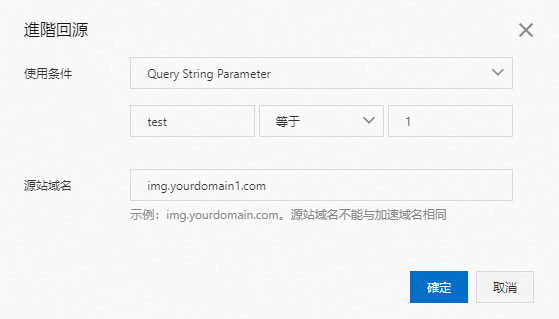進階回源可以根據用戶端請求的Request Header、Query String Parameter、Path、Request Cookie不同參數回到不同的來源站點。本文為您介紹配置進階回源功能的操作步驟。
注意事項
配置數量:最多可以設定120條規則。
功能衝突:條件來源站點功能與進階回源功能存在功能衝突,只能二選一配置。
- 匹配順序:按照功能配置列表中的配置,從上到下順序匹配,命中某一條以後就不再繼續向下匹配。
條件來源站點與基礎來源站點、進階回源的區別
- 基礎來源站點地址是使用者請求回源時使用的預設來源站點地址,當使用者請求與條件來源站點、進階回源這兩個功能中的規則條件都沒有匹配的時候,將使用基礎來源站點地址。
- 使用者請求與條件來源站點、進階回源這兩個功能中的規則條件匹配上的時候,將使用在條件來源站點、進階回源中設定的來源站點地址。
- 條件來源站點功能是進階回源功能的增強版,能夠引用在規則引擎功能中配置的規則條件,因而可以配置更加靈活的回源策略。
操作步驟
登入CDN控制台。
在左側導覽列,單擊域名管理。
在域名管理頁面,找到目標網域名稱,單擊操作列的管理。
在指定網域名稱的左側導覽列,單擊回源配置。
在進階回源地區,單擊添加。
在進階回源對話方塊中,選擇使用条件並填寫源站域名。
說明任意選擇Request Header、Query String Parameter、Path、Request Cookie配置不同來源站點。CDN節點在接收到用戶端請求後將讀取請求中對應的欄位進行判斷並回源到不同來源站點。

單擊確定。
樣本
CDN節點行為:接收到的請求中含參數 test=1 時,該請求回源至img.yourdomain1.com來源站點。